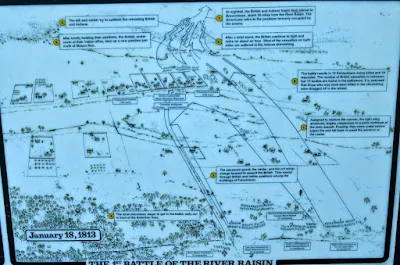The Battles of Frenchtown, better known as the Battle of the River Raisin or the River Raisin Massacre, was a series of battles in Michigan Territory that took place from January 18–23, 1813. These were two separate and different actions fought during the War of 1812. They were also different from most battles I have fought in that the majority of troops were Militia, Volunteers and Native Americans. The second battle did include small detachment of regulars for each side. Both battles were fought in the winter so again these will be very different types of actions.
 |
| Wayside from battle site of the second battle. |
 |
| Wayside of the first battle. |
For a quick history lesson here is a recounting of the actual historical events. http://en.wikipedia.org/wiki/Battle_of_Frenchtown
The first battle (January 18) saw a American Force of Kentucky Militia and Volunteers capturing the village from a smaller group of Indians and Canadian militia. The second battle saw the British/Canadians recapturing the town. Both sides included regulars and the British had two small cannon. The battles were better suited to a skirmish action or a Sharp Practice type game. I am upping the number of figures per each unit but keeping the ratio of figures per side to fit my collection. So this will not be a full historical recreation. More of a Hollywood based on type story.
Order of Battle:
18 January:
Defending the village of Frenchtown:
Canadian militia regiment (24 figures)
Native Warriors (12 figures)
American attacking force:
2x American militia regiments (24 each)
1 x Rifle regiment (12 figures)
January 23;
Americans defending Frenchtown
2 x Militia regiments (24 figures)
1 x Rifle unit (12 figures)
1 x US Regulars (24 figures)
British Canadian attach force:
1 x British Regular (24 figures)
2 x Canadian militia (24 figures each)
2 x Native Warriors (12 each)
Royal Artillery (2 x light guns)




















































